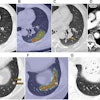The prevalence of advanced neoplasia in subcentimeter polyps is extremely rare, according to a new meta-analysis of virtual colonoscopy data from more than 20,000 patients. As a result, the study authors believe that it's unnecessary to incur the costs and risks associated with resecting diminutive colorectal lesions detected at VC.
The retrospective study, which appeared in Alimentary Pharmacology and Therapeutics (published online October 8, 2009, before print), analyzed several large virtual colonoscopy (also known as CT colonography or CTC) screening studies published in the past six years.
To evaluate the consequences of not referring polyps below a certain size threshold, previous studies have tended to focus on the individual or anecdotal risk of advanced neoplasia in subjects with only small polyps, "generating concern for the validity of this policy," wrote gastroenterologist Dr. Cesare Hassan et al from Nuovo Regina Margherita Hospital in Rome, along with colleagues Dr. Perry Pickhardt and Dr. David Kim from the University of Wisconsin in Madison and Dr. Andrea Laghi et al from the University of Rome "La Sapienza."
Anecdotal risk as defined in these studies does not necessarily correlate with screening efficacy on a population basis, which is based on the overall burden of advanced neoplasia, the authors noted. "If more individuals are being screened as a result of additional options, the benefit related to the increased detection of large adenomas and cancers should not be overlooked," they wrote.
As a result, any screening program that reduces the incidence and mortality of the disease "should be balanced with the simplicity, acceptability, safety, cost-effectiveness, and impact on overall compliance of a screening program," Hassan and his team wrote.
The researchers examined published studies reporting the distribution of advanced adenomas in asymptomatic screening cohorts according to polyp size, using literature searches on Medline and Embase.
They looked at the reported screening rates of advanced adenomas represented by diminutive (≤ 5 mm), small (6-9 mm), subcentimeter (< 10 mm), and large (≥ 10 mm) polyp sizes.
The inclusion criteria for studies included an average-risk asymptomatic population, optical colonoscopy as the gold standard, and definition of an advanced adenoma as 10 mm or larger with high-grade dysplasia or a prominent villous component. The minimum study size was 500 individuals, and the findings had to be evaluated according to polyp size.
The 20,562 individuals were contained in four studies:
- 1,233 individuals from Pickhardt et al (2003)
- 3,163 from Kim et al (2007)
- 13,992 from Lieberman et al (2008)
- 2,174 from Rex et al (2009)
The mean age (available in two of four studies) was 58 years, with a pooled average of 53% men and 47% women, and a positive family history of colorectal polyps or cancer ranging from 3% to 22% (median, 8%).
"Optical colonoscopy [OC] was the only technique applied in three studies; in the remaining series CTC was performed, in addition to OC in all cases," Hassan and colleagues wrote.
Advanced adenomas were found in 1,155 of the 20,562 subjects, with an overall pooled prevalence of 5.6% (95% confidence interval [CI] = 5.3-5.9). The presence of diminutive polyps (≤ 5 mm) as the largest polyp accounted for 4.6% of patients with advanced neoplasia (53 of 1,155; 95% CI = 3.4-5.8) and ranged from 2% to 5% among the studies.
Patients with small polyps (6-9 mm) as their largest lesion accounted for 7.9% (91 of 1,155; 95% CI = 6.3-9.4) of cases with advanced adenomas, with a range of 7% to 11%.
Combining all subcentimeter lesions, a total of 12.5% (144 of 1,155; 95% CI = 10.6-14.0) of patients with advanced adenomas did not have a large lesion; in contrast, the rate of advanced adenomas represented by large lesions (≥ 10 mm) was 87.5% (1,011 of 1,155; 95% CI = 86.0-89.4).
The mean prevalence of diminutive (≤ 5 mm), small (6-9 mm), and large (≥ 10 mm) polyps was 27%, 9%, and 6%, respectively.
"Fewer than 1% of patients with diminutive-only lesions had an advanced adenoma, whereas < 5% of patients with a small (6-9 mm) lesion had an advanced adenoma," they wrote. "In comparison, over 70% of patients with a large polyp had an advanced lesion." Finally, fewer than 0.1% of patients with a subcentimeter polyp as the largest lesion had a cancer.
The review "clearly shows that subcentimeter polyps contribute very little to the overall burden of advanced neoplasia in an average-risk population," they wrote. "It is remarkable how homogeneous the data are among the studies that met our inclusion criteria."
Assuming a 5.6% prevalence of advanced adenomas and a progression of 3.3% per year from advanced adenomas to cancer, the five-year cancer risk associated with the 4.6% of advanced neoplasia represented by diminutive polyps would be 0.04%. This compares with a 0.07% (6-9 mm) and 0.88% (≥ 6 mm) five-year cancer risk associated with the larger polyps.
In terms of colorectal cancer risk, the gap between individuals with diminutive polyps and those with small and medium-sized lesions "corresponds to [a] difference of one cancer for every 2,380 screened subjects related to diminutive lesions," they wrote. As a result, additional screening of patients with diminutive and small polyps is not worth the additional time, cost, and risk that would be incurred.
"To perform a relatively expensive and invasive test as colonoscopy for such a high percentage of adults undergoing CTC screening would severely hamper the acceptability and the cost-effectiveness of an otherwise less invasive approach," Hassan and colleagues wrote. "Moreover, endoscopy would be uselessly forced to work up a low-risk population depleted from advanced neoplasia, as shown by the very low likelihood of advanced neoplasia (< 1%) among adults whose largest polyp is diminutive in size. On the other hand, ignoring diminutive lesions would relieve the major burden of post-test endoscopic work-up, with a minimal loss of screening efficacy."
For patients with a small (6-9 mm) polyp, the likelihood of harboring advanced neoplasia is about 5%, and the need for an invasive test is even less urgent for CTC-screened patients because the polyps can be monitored in vivo.
"Our systematic review provides convincing evidence that subcentimeter polyps do not represent suitable target lesions for less invasive, nontherapeutic screening tests such as CTC," they wrote. "A policy of referring all CTC-detected small or diminutive polyps would result in the loss of simplicity, acceptability, and feasibility of such screening, without substantially improving screening efficacy."
By Eric Barnes
AuntMinnie.com staff writer
November 2, 2009
Related Reading
ACRIN: Virtual colonoscopy sensitive for flat polyps, October 13, 2009
Colon cancer screening every 10 years OK for some at risk, July 22, 2209
VC is cost-effective for screening; tiny polyps can be ignored, July 15, 2009
Colonoscopy seen reducing CRC mortality in Germany, March 23, 2009
Copyright © 2009 AuntMinnie.com




















